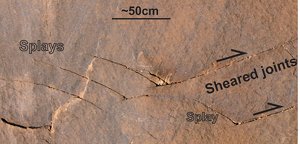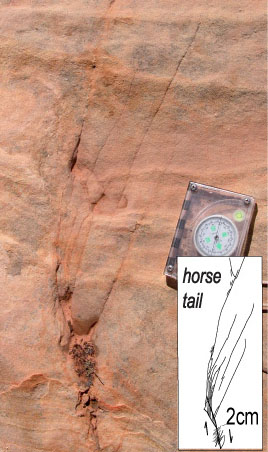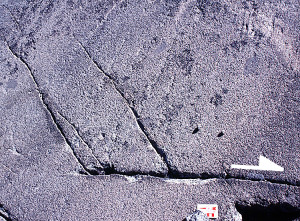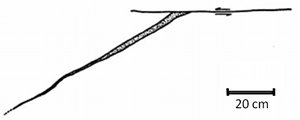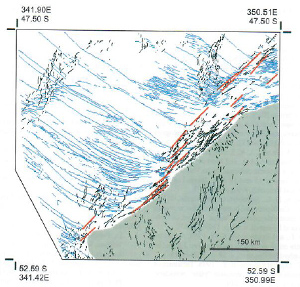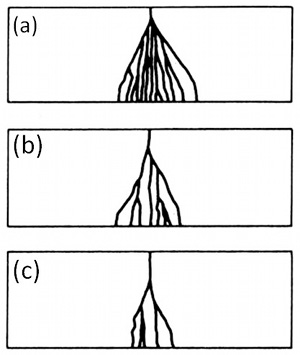| |||||||
|
|
|||||||
| Splay Joints | |||||||
|
The term splay joint refers to a type of joint formed by the shearing of an existing discontinuity. Splay joints (Figure 1) occur in the extensional quadrants with respect to the sense of shear across a fracture and are oriented at an angle to the sheared fracture called splay angle or kink angle. Splay joints are also referred to as tail cracks, wing cracks, and horse tail fractures. Horse tail fractures are used for multiple splay joints spaced closely at or near their initiation and fan out as the splays propagate away (Figure 2). In simple configurations, splay joints usually occur at the extensional quadrants of the two ends of sheared discontinuity. Figure 3 shows splay joints in granitic rock at a higher angle than those of the previous examples. Examples of splays forming at right-angle to the sheared fractures are also presented in this Knowledgebase. For additional images of splay joints and their kink angles, please see the links under 'Related Concepts.' Splay joints may have a significant impact on the fluid flow properties of rocks as indicated by hydrothermal precipitations in them. They are then called 'veins' (Figure 4). A little bit of shearing across a sheared discontinuity may produce splays that reach adjacent fractures, thus significantly enhancing the connectivity of sub-parallel fractures. In mature fault zones, the associated damage zones are intensively broken up by splay joints and sheared splay joints. The density, the maximum length, and the kink or splay angle of these fractures in a damage zone will determine the fluid flow properties of the fault zones as well as their strength. For more discussion on this topic, please refer to sections Fracture Frequency in Fault Damage Zone, Scaling between Fault Length and Maximum Splay Length, and Splay (Kink) Angle. Splay fractures with exceptionally large size may also occur. Examples of these are shown in the map in Figure 5, which are interpreted to be associated with some strike-slip faults on the surface of Venus (Koenig and Aydin, 1998). There, the maximum length of the splay fractures appears to be on the order of several hundred kilometers. There is a sister structure closely related to a splay joint, called a joint branch structure (Figure 6). Splay joints are considered to be associated with primary shear fractures. On the other hand, a joint branch is due to the bifurcation of a primary fracture into two or more branches with similar kinematics. The latter is referred to as a dynamic fracturing. Crack branching is generally associated with high fracture propagation velocity.
| |||||||
| Reference: |
|||||||
| Aydin, A., Muller, J.R., Bergbauer, S., Eichhubl, P., Du, Y., Du Bernard, X., 2002 de Joussineau, G., Mutlu, O., Aydin, A., Pollard, D.D., 2007 de Joussineau, G., Aydin, A., 2007 Koneig, E., Aydin, A., 1998 Lawn, B.R., Wilshaw, T.R., 1975 Pollard, D.D., Fletcher, R.C., 2005 Segall, P., Pollard, D.D., 1983 |
|||||||
|
Readme | About Us | Acknowledgement | How to Cite | Terms of Use | Ⓒ Rock Fracture Knowledgebase |
|||||||
